
How to Use RFID-RC522_32b368d26333377f3b2822620679be01_1_schematic: Examples, Pinouts, and Specs
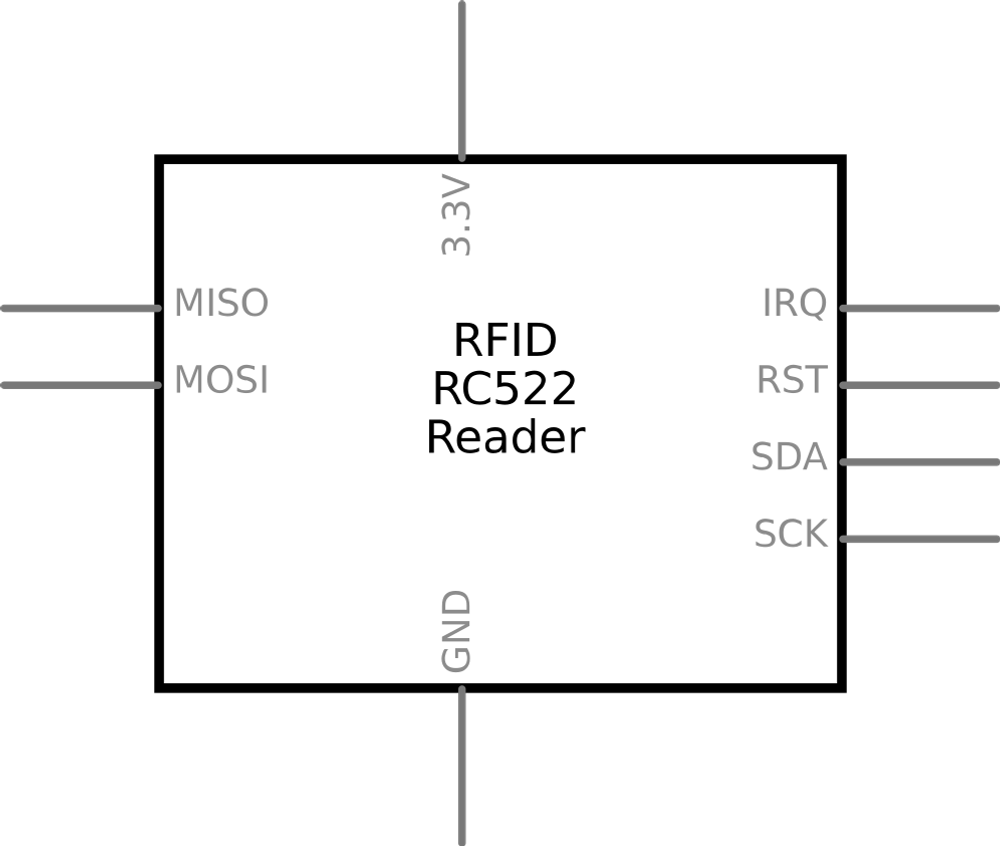
 Design with RFID-RC522_32b368d26333377f3b2822620679be01_1_schematic in Cirkit Designer
Design with RFID-RC522_32b368d26333377f3b2822620679be01_1_schematic in Cirkit DesignerIntroduction
The RFID-RC522 is a compact and cost-effective RFID reader/writer module that operates at a frequency of 13.56 MHz. It is designed for reading and writing RFID tags and cards, making it an essential component for wireless communication in various applications. The module is widely used in access control systems, inventory management, and identification systems due to its reliability, affordability, and ease of integration.
Explore Projects Built with RFID-RC522_32b368d26333377f3b2822620679be01_1_schematic
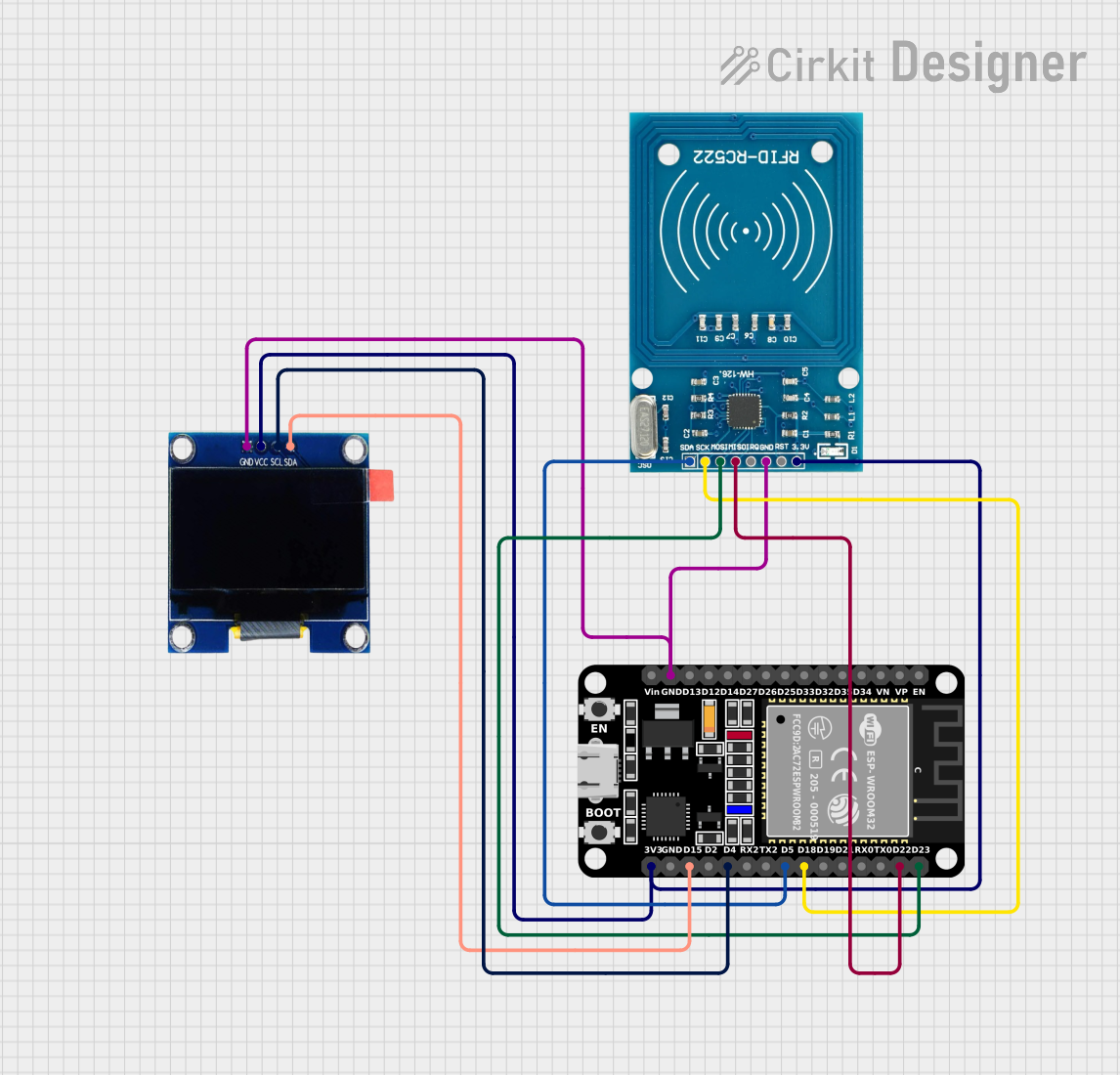
 Open Project in Cirkit Designer
Open Project in Cirkit Designer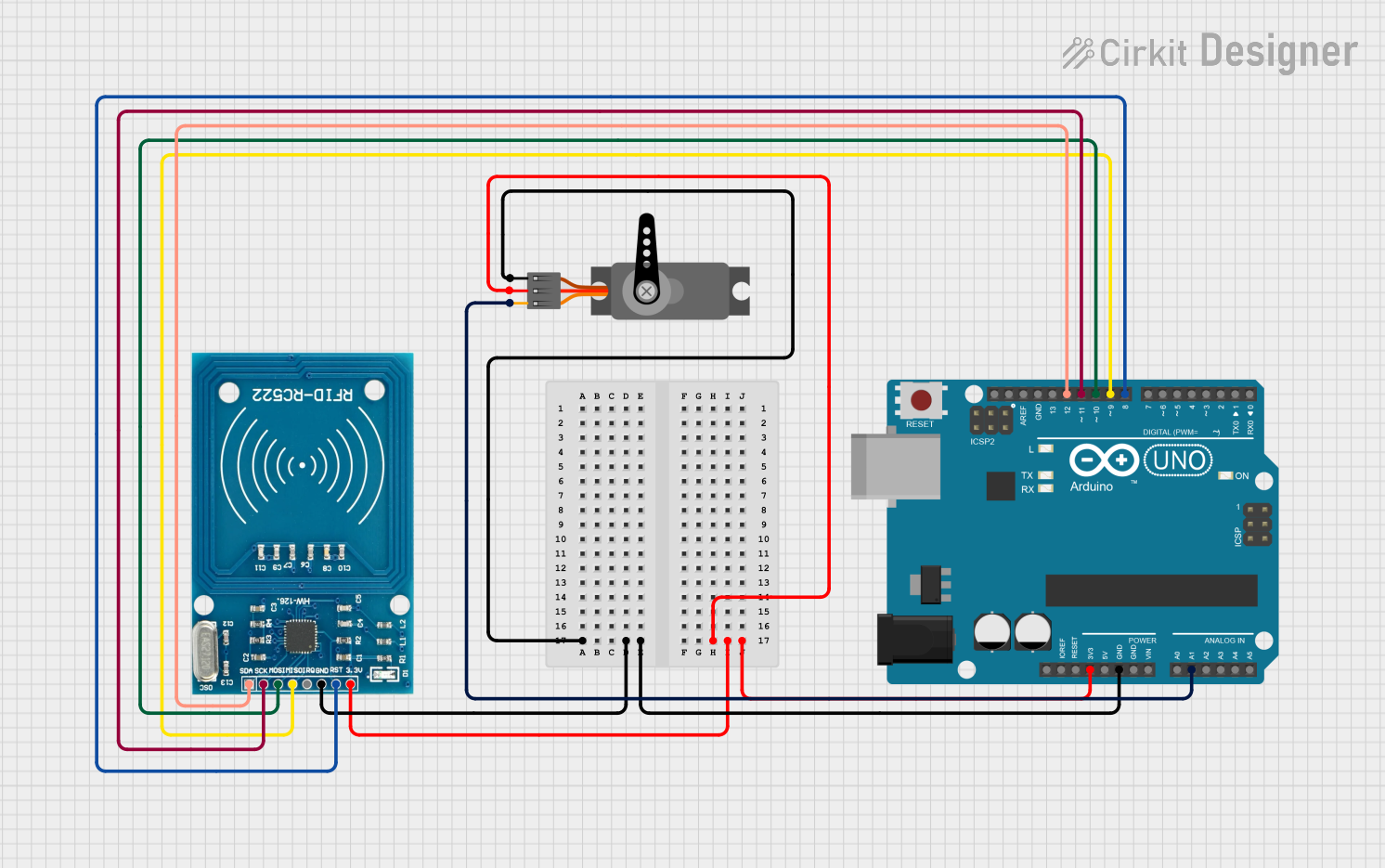
 Open Project in Cirkit Designer
Open Project in Cirkit Designer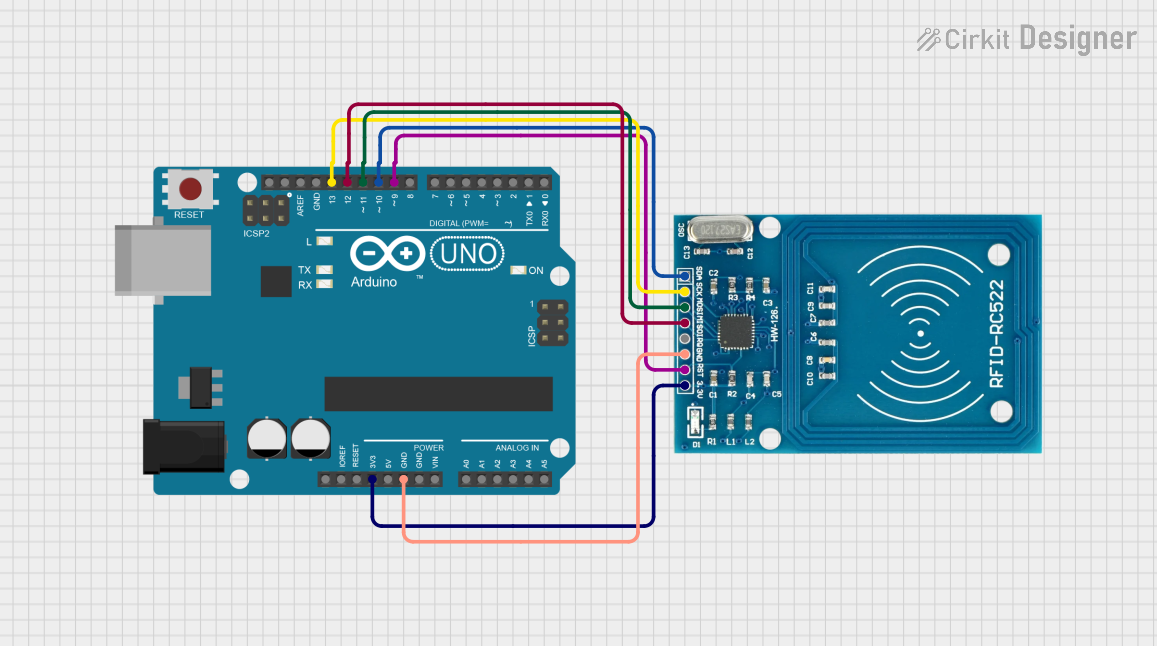
 Open Project in Cirkit Designer
Open Project in Cirkit Designer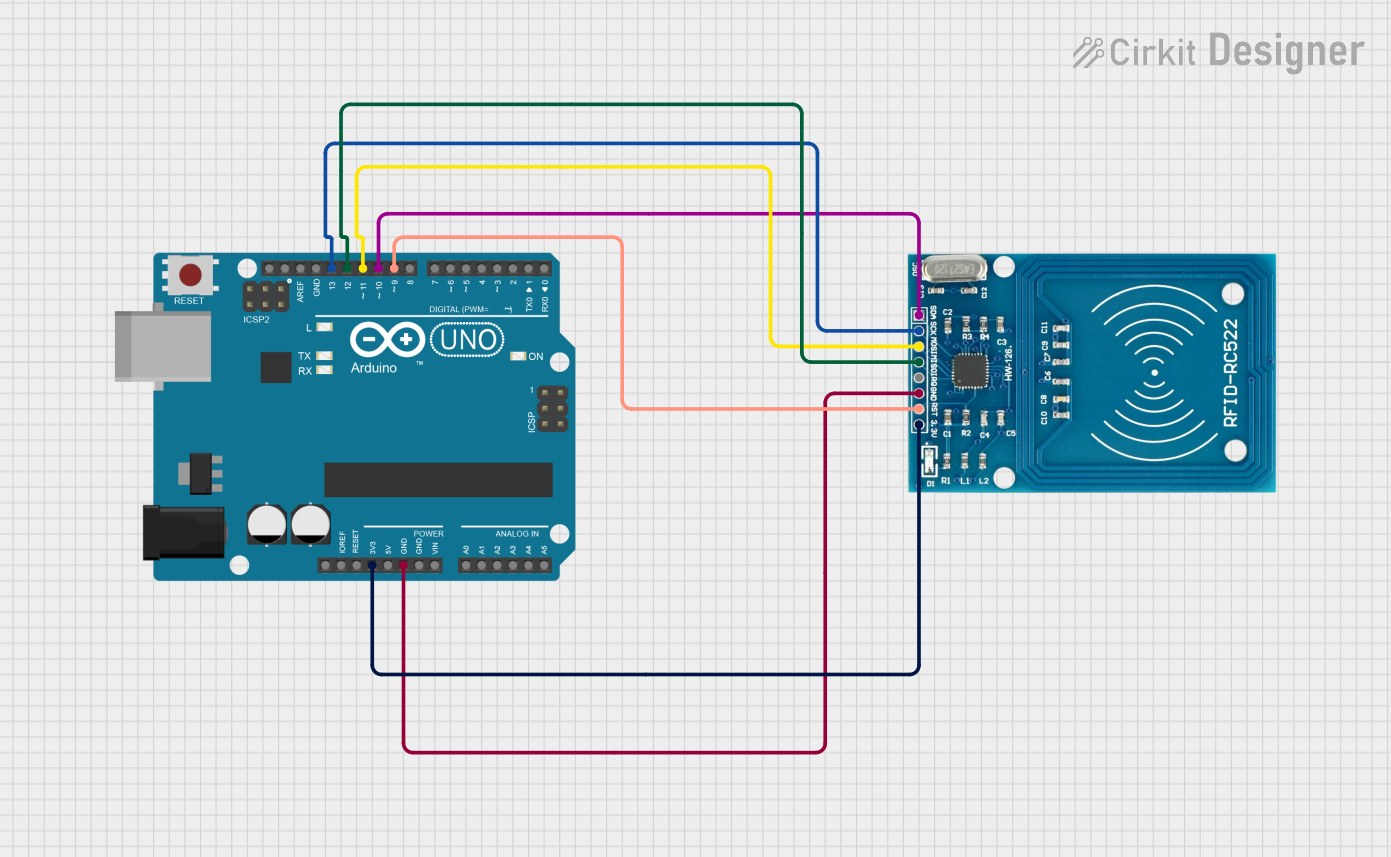
 Open Project in Cirkit Designer
Open Project in Cirkit DesignerExplore Projects Built with RFID-RC522_32b368d26333377f3b2822620679be01_1_schematic

 Open Project in Cirkit Designer
Open Project in Cirkit Designer
 Open Project in Cirkit Designer
Open Project in Cirkit Designer
 Open Project in Cirkit Designer
Open Project in Cirkit Designer
 Open Project in Cirkit Designer
Open Project in Cirkit DesignerCommon Applications:
- Access control systems (e.g., door locks, attendance systems)
- Inventory and asset tracking
- Contactless payment systems
- Identification and authentication systems
- Smart card-based projects
Technical Specifications
The RFID-RC522 module is built around the MFRC522 IC, which supports ISO/IEC 14443A/MIFARE protocols. Below are the key technical details and pin configurations:
Key Technical Details:
| Parameter | Specification |
|---|---|
| Operating Voltage | 2.5V to 3.3V (logic level: 3.3V) |
| Power Supply Voltage | 3.3V |
| Operating Current | 13-26mA |
| Operating Frequency | 13.56 MHz |
| Communication Interface | SPI, I2C, UART |
| Maximum Data Rate | 10 Mbps |
| Reading Distance | Up to 5 cm (depending on tag type) |
| Dimensions | 40mm x 60mm |
Pin Configuration and Descriptions:
The RFID-RC522 module has an 8-pin interface for communication and power. Below is the pinout:
| Pin Name | Pin Number | Description |
|---|---|---|
| VCC | 1 | Power supply input (3.3V) |
| RST | 2 | Reset pin (active LOW) |
| GND | 3 | Ground connection |
| IRQ | 4 | Interrupt pin (optional, used for advanced applications) |
| MISO | 5 | Master In Slave Out (SPI data output) |
| MOSI | 6 | Master Out Slave In (SPI data input) |
| SCK | 7 | Serial Clock (SPI clock signal) |
| SDA/SS | 8 | Slave Select (SPI chip select) or I2C address selection (depending on mode) |
Usage Instructions
How to Use the RFID-RC522 in a Circuit:
- Power the Module: Connect the VCC pin to a 3.3V power source and the GND pin to ground.
- Connect Communication Pins: Use the SPI interface to connect the module to a microcontroller (e.g., Arduino UNO). The connections are as follows:
MISOto Arduino pin 12MOSIto Arduino pin 11SCKto Arduino pin 13SDA/SSto Arduino pin 10RSTto Arduino pin 9
- Install Required Libraries: For Arduino, install the "MFRC522" library from the Arduino IDE Library Manager.
- Upload Code: Use the example code provided below to test the module.
Example Code for Arduino UNO:
#include <SPI.h>
#include <MFRC522.h>
// Define pins for the RFID-RC522 module
#define RST_PIN 9 // Reset pin connected to Arduino pin 9
#define SS_PIN 10 // Slave Select pin connected to Arduino pin 10
MFRC522 rfid(SS_PIN, RST_PIN); // Create an instance of the MFRC522 class
void setup() {
Serial.begin(9600); // Initialize serial communication
SPI.begin(); // Initialize SPI bus
rfid.PCD_Init(); // Initialize the RFID module
Serial.println("Place your RFID card near the reader...");
}
void loop() {
// Check if an RFID card is present
if (!rfid.PICC_IsNewCardPresent() || !rfid.PICC_ReadCardSerial()) {
return; // Exit if no card is detected
}
// Print the UID of the detected card
Serial.print("Card UID: ");
for (byte i = 0; i < rfid.uid.size; i++) {
Serial.print(rfid.uid.uidByte[i], HEX); // Print each byte in hexadecimal
Serial.print(" ");
}
Serial.println();
// Halt the card to stop further communication
rfid.PICC_HaltA();
}
Important Considerations:
- Voltage Levels: The module operates at 3.3V logic levels. If using a 5V microcontroller (e.g., Arduino UNO), use a level shifter or voltage divider for the SPI pins.
- Reading Distance: Ensure the RFID tag/card is within 5 cm of the module for reliable communication.
- Interference: Avoid placing the module near metal objects or other RF devices to minimize interference.
Troubleshooting and FAQs
Common Issues and Solutions:
Module Not Responding:
- Ensure the module is powered with 3.3V and all connections are secure.
- Verify that the SPI pins are correctly connected to the microcontroller.
Card Not Detected:
- Check the reading distance and ensure the card/tag is compatible with the module (ISO/IEC 14443A).
- Avoid interference from nearby metal objects or other RF devices.
Incorrect UID Output:
- Verify that the SPI communication speed is set correctly in the code.
- Ensure the MFRC522 library is properly installed and up to date.
FAQs:
Q: Can the RFID-RC522 module write data to RFID tags?
A: Yes, the module supports both reading and writing operations for compatible RFID tags.Q: Can I use the module with a 5V microcontroller?
A: Yes, but you must use a level shifter or voltage divider for the SPI pins to avoid damaging the module.Q: What is the maximum range of the RFID-RC522?
A: The maximum reading distance is approximately 5 cm, depending on the tag type and environmental conditions.
By following this documentation, you can effectively integrate the RFID-RC522 module into your projects and troubleshoot common issues.